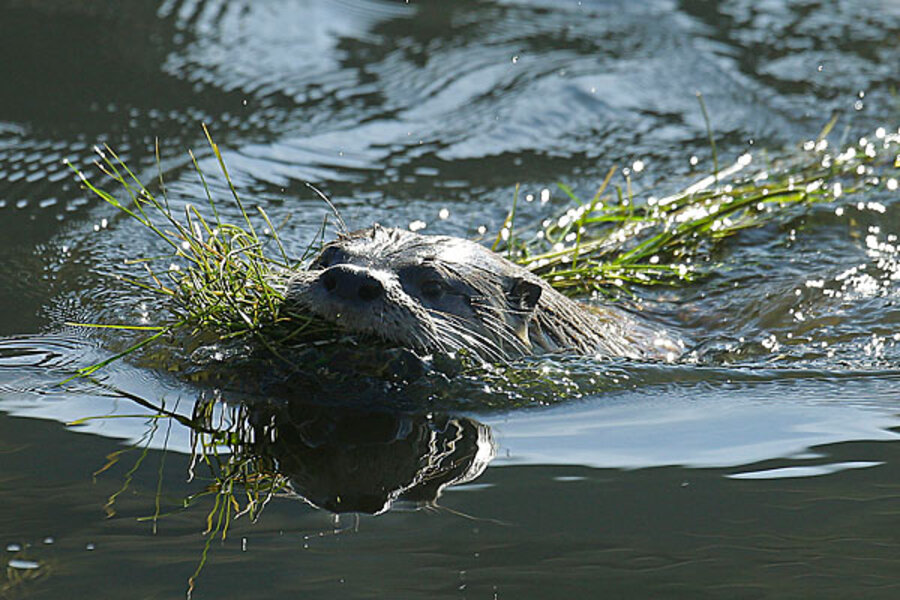Rare river otter returns to San Francisco – a sign of progress?
Loading...
| San Francisco
A rapt crowd followed a trail of bubbles that zipped over the surface of a seaside pond in the ruins of a 19th century bath in San Francisco.
San Francisco's newest star — the first river otter seen in the city in decades — surfaced its whiskery head furtively, a mouth full of sea grass. The crowd oohed as large waves pounded rocks just offshore, a briny smell and chill in the air.
The otter ducked back under water and took the sea grass underneath a concrete remnant of the historic baths, where the animal was building a nest.
"We came here to see the baths and this was just a bonus," said Eliza Durkin, who brought her son Jonathan to the site for a school project on historic places.
Beyond tourists, the otter has mystified and delighted conservationists, who are piecing together clues to figure out how he got there. The furry creature was first spotted by birdwatchers in September and has since settled into the City by the Bay.
River otters once thrived in the San Francisco Bay area, but development, hunting and environmental pollution in the 19th and 20th centuries has taken its toll on the once thriving local population.
The critters are a living barometer of water quality - if it's bad they cannot thrive. But new populations being seen north and east of San Francisco are giving hope to conservationists that years of environmental regulations and new technologies are making a difference.
"The fact that this otter is in San Francisco and doing so well in other regions of the Bay Area, it's a good message that there's hope for the watershed," said Megan Isadore, director of outreach and education for the River Otter Ecology Project, a group that studies otter populations further north and in the bay.
The group said until now it had no evidence the creatures had returned to San Francisco, and the last sighting was nearly a half-century ago as best they can tell.
The otter is nicknamed "Sutro Sam" after the old baths, which were named after former San Francisco Mayor Adolph Sutro, who built the building which at the time was an engineering marvel.
The facility opened in 1896 on a cliff facing the Pacific Ocean, its baths fed by the salty ocean tides and a freshwater seep. They were torn down and burned in a fire in 1966, and the building's carcass has long been a tourist draw on the city's rugged, western shoreline.
The aquatic mammal seems to have found the mix of the environment he needs to make a home, to the delight of tourists and local nature lovers.
"They do need freshwater to drink and keep their fur clean," Isadore said. "They are also happy in salt and brackish water — wherever there is food — and he is getting freshwater from seeps behind the baths."
River otters can be found in other regions of the San Francisco Bay area. To the north of the Golden Gate, the researchers are tracking a group in Marin County. They have also found river otters in shore-side San Francisco Bay area communities of Alameda, Richmond and Martinez.
"Habitat destruction had an impact on the river otters," said Dorren Gurrola, a science teacher at the Marine Mammal Center, which studies Sam's relatives, the sea otter. "So it's always exciting to see these animals return to their habitat."
Young males like Sam often are the ones that travel away from groups, looking for food. If they find a new, hospitable habitat, others including females may join and create the basis of a new colony, Gurrola said.
While there is no certain reason for Sam's appearance in San Francisco, Isadore and biologists working to unlock more clues have some leads to go on.
He could have swam across the bay's mouth from Marin County, and scat collected from Sam will be analyzed to see if there's a genetic link to that population. But now, Sam seems to be happy swimming around and munching on small fish, including goldfish discarded in the area.
"We're just trying to piece things together in a logical way," Isadore said. "River otters sometimes even stow away on boats, we just don't know."
Copyright 2013 The Associated Press.





